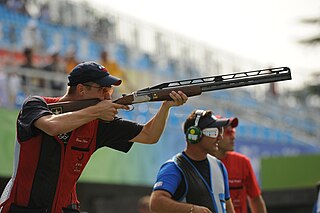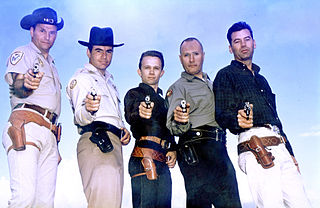
The Weaver stance is a shooting technique for handguns. It was developed by Los Angeles County Deputy Sheriff Jack Weaver during freestyle pistol competition in Southern California during the late 1950s.

The Weaver stance is a shooting technique for handguns. It was developed by Los Angeles County Deputy Sheriff Jack Weaver during freestyle pistol competition in Southern California during the late 1950s.
The Weaver stance has two main components. [1]
A left-handed shooter would reverse the hands and the footing, respectively.
The Weaver stance is one of five components of the modern technique of shooting developed by Jeff Cooper. The others are a large-caliber handgun, the flash sight picture, and the compressed surprise break.
The Weaver stance was developed in 1959 by pistol shooter and deputy sheriff Jack Weaver, a range officer at the L.A. County Sheriff's Mira Loma pistol range. At the time, Weaver was competing in Jeff Cooper's "Leatherslap" matches: quick draw, man-on-man competition in which two shooters vied to pop twelve 18" wide balloons set up 21 feet away, whichever shooter burst all the balloons first winning the bout. Weaver developed his technique as a way to draw a handgun quickly to eye level and use the weapon's sights to aim more accurately, and immediately began winning against opponents predominantly using unsighted "hip shooting" techniques.
The Weaver technique was dubbed the "Weaver Stance" by gun writer and firearms instructor Jeff Cooper. Cooper widely publicized the Weaver stance in several of his books, as well as in articles published in the then-fledgling Guns & Ammo magazine. When Cooper started the American Pistol Institute firearms training school, now the Gunsite Training Center, in 1977, his modern technique of the pistol was built around a somewhat formalized "Classic Weaver Stance". Due to Cooper's influence, the Weaver stance became very popular among firearm professionals and enthusiasts.

Shooting is the act or process of discharging a projectile from a ranged weapon. Even the acts of launching flame, artillery, darts, harpoons, grenades, rockets, and guided missiles can be considered acts of shooting. When using a firearm, the act of shooting is often called firing as it involves initiating a combustion (deflagration) of chemical propellants.

Point shooting, also known as target- or threat-focused shooting, intuitive shooting, instinctive shooting or subconscious tactical shooting, is a practical shooting method where the shooter points a ranged weapon at a target without relying on the use of sights to aim, where the emphasis is more on fast draw and trying to score preemptive hits first. In close quarters combat where life-threatening situations often arise suddenly leaving little reaction time for precise aiming, it is difficult to apply proper marksmanship techniques without risking oneself to be hit and thus suffer injury or get killed, which is why point shooting advocates a less sighting-oriented style of shooting prioritizing on achieving a tactical advantage through quick fire superiority and suppression.
Combat pistol shooting is a modern martial art that focuses on the use of the handgun as a defensive weapon for self defense, or for military and police use. Like most martial arts, combat pistol shooting is practiced both for defense and for sport.

Kimber Manufacturing is an American company that designs, manufactures, and distributes small arms such as M1911 pistols, Solo pistols and rifles. The USA Shooting Team, Marines assigned to Special Operations Command, and the LAPD SWAT team have used Kimber pistols in the past.
A gunstock or often simply stock, the back portion of which is also known as a shoulder stock, a buttstock or simply a butt, is a part of a long gun that provides structural support, to which the barrel, action, and firing mechanism are attached. The stock also provides a means for the shooter to firmly brace the gun and easily aim with stability by being held against the user's shoulder when shooting the gun, and helps to counter muzzle rise by transmitting recoil straight into the shooter's body.

The Beretta U22 Neos is a .22 Long Rifle semi-automatic, single-action pistol using a slide blow-back system, that has been manufactured in the United States since 2002 by Beretta USA. The pistol will accept interchangeable 4.5, 6 or 7.5 in barrels in blued or stainless steel finishes. Each barrel incorporates a built-in Weaver-style rail to accommodate optics or accessories. Beretta markets the Neos as a modern, reasonably priced pistol suitable for a beginner, yet is customizable to suit the experienced marksman.

The K100 is a 9×19mm semi-automatic pistol designed and built by Grand Power s.r.o. in Slovenská Ľupča, Slovakia located approximately 11 kilometers east of Banská Bystrica, Slovakia which is the region's major city.

John Dean "Jeff" Cooper was a United States Marine, the creator of a "modern technique" of handgun shooting, and an expert on the use and history of small arms.

Locked breech is the design of a breech-reloading firearm's action. This is important in understanding how a self-reloading firearm works. In the simplest terms, the locked breech is one way to slow down the opening of the breech of a self-reloading firearm when fired. The source of power for the movement is recoil.
Berns-Martin is the name given to a brand of split-front holster made only for a revolver. This type of holster was later referred to as a "Break Front" during the 1970s with the introduction of such a model by the Bianchi Holster Co.
Karate has many different stances, each used to for different types of power and movement. In Japanese the general term is {{Nihongo| ( Dachi) changing to dachi when used as a suffix. Some stances focus more on mobility than stability, and vice versa.
Limp wristing is a phenomenon commonly encountered by semi-automatic pistol shooters, where the shooter's grip is not firm enough and the wrist is not held firm/straight enough to keep the frame of the firearm from traveling rearward while the bolt or slide of the pistol cycles. This condition often results in a failure to complete the operating cycle, properly termed a malfunction, but commonly termed a "jam". Rifles and shotguns, if fired without the stock in the shoulder, may also be prone to limp wristing. Of the important variables involved in this type of malfunction, bullet and gas momentum, slide and barrel mass, recoil spring pre-load and spring rate, and shooting hand and arm mass are much more important than the compliance (limpness) of the wrist.

Throughout the history of gloved boxing styles, techniques and strategies have changed to varying degrees. Ring conditions, promoter demands, teaching techniques, and the influence of successful boxers are some of the reasons styles and strategies have fluctuated.

A vertical forward grip or foregrip is a vertical pistol grip mounted on the fore-end of a long-barrel firearm, designed for grasping by the frontal support hand.
The modern technique is a method for using a handgun for self-defense, originated by firearms expert Jeff Cooper. The modern technique uses a two-handed grip on the pistol and brings the weapon to eye level so that the sights may be used to aim at the target. This method was developed by Cooper into a teachable system beginning in the 1950s, based on the techniques of shooters like Jack Weaver, Mike Rousseau and others, after experiments with older techniques such as point shooting. The method was codified in book form in 1991 in The Modern Technique of the Pistol by Gregory B. Morrison and Cooper.

Gunsite is a privately run firearms training facility based in Yavapai County, Arizona, just south-west of Paulden in the United States. It offers tuition-based instruction in handgun, carbine, rifle and shotgun shooting, as well as other specialty firearms. Located on a 3,000-acre (12 km2) facility, Gunsite has classrooms, indoor and outdoor firing simulators, and various pistol and long-barrel ranges. The ranges go out to 2000 yards for precision rifle training. There is also an on-site pro shop and gunsmith.

John Harold Weaver was a Los Angeles County Deputy Sheriff and the developer of the Weaver stance, a popular shooting stance for firing handguns.
The Art of the Rifle is a concise book explaining the use and techniques of rifles. It was authored by Lt. Col. (R) Jeff Cooper (1920–2006) and published in 1997. In it, Cooper uses short chapters to teach about both physical and mental preparedness for successful rifle shooting, whether for defense, hunting, or competition. His goal was to help the rifle shooter be accurate at any time or place. Col. Cooper was particularly well known for his pistol shooting expertise, popularizing the widely used “Weaver stance” and establishing a large training center in Arizona for military, law enforcement and civilians interested in gaining skill with firearms and defense techniques. Col. Cooper also authored at least half a dozen other books related to shooting since the 1950s. As of 2012, The Art of the Rifle was still in print in hardcover, softcover and electronic formats.
The Isosceles shooting stance is a shooting technique for handguns. It became popular in the 1980s when Brian Enos and Rob Leatham started using it to win International Practical Shooting Confederation competitions. It is one of the two main stances for pistol shooting alongside the Weaver stance.

The Remington R51 is a semi-automatic pistol announced in late 2013 and was available to the market in January 2014. The R51 is a modernized version of the John Pedersen-designed Remington Model 51 pistol now chambered in 9×19mm caliber. Remington announced plans to offer the pistol in .40 S&W and other calibers. However, no other chamberings were offered by the time of Remington's bankruptcy in 2018.